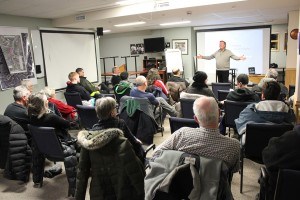
There were several tense exchanges between members of the public and a risk management consultant during a public forum about Jasper’s recent tobogganing closures held Feb. 6.
Residents condemned the municipality’s decision to close two popular tobogganing areas in late January over safety concerns and demanded the town find a way to mitigate the risks.
One of about 20 people who attended the meeting described the decision as a “knee-jerk reaction” while another said it felt like a “war on the poor.”
“Taking my son to the ski hill? I can’t afford that,” said Bas Byrd, a local resident.
“I’m a poor family. I need an outside activity for my son to enjoy.”
Other residents questioned whether the risk was being taken out of context.
“Hundreds of thousands of kids go tobogganing every day, you’ve had four deaths, so let’s put that in perspective a little bit,” said one resident, referring to the number of tobogganing fatalities the risk consultant has investigated in his career.
“One death is too many, I’m not saying that, but if we put that in perspective generations and generations of kids go tobogganing and nothing ever happens.”
In January, Doug Wyseman, an independent risk consultant, strongly recommended the municipality’s administration close Snape’s Hill and the church hill to address safety concerns. Both hills spill out onto roads and there is a fire hydrant at the end of the church hill.
The hill at Centennial Park remains open for use.
In response, residents held a tobogganing event in defiance of the closure on Jan. 20 and started a petition demanding administration reverse its decision. To date, more than 250 people have signed.
“Risk is an important part of recreation and I’m not here to say no to risk,” said Wyseman, who has worked as a risk consult for various levels of government across North America. “The idea isn’t to injury-proof everything, but it’s a matter about finding the balance between risk and reward.”
He acknowledged people’s concerns, but said the present state of both hills poses an unacceptable risk.
“If you know the danger you have an obligation to protect people from it.”
According to Wyseman, between 2005 and 2015 there was an average of 544 emergency room visits per year for people with tobogganing injuries in Alberta. Fifty-seven precent of those injuries were children between four and 14 years of age.
In January, Bruce Thompson, director of operations, said he was unaware of any legal claims against the municipality related to tobogganing.
During Wyseman’s presentation he talked at length about the various fatal accidents he’s had to investigate over his career, including four tobogganing fatalities.
“Of the four fatal accidents that I’ve investigated, none of (the hills) were as bad as church hill,” said Wyseman.
To mitigate the risks he floated several ideas, including moving the starting point lower by installing fencing at the top of the hill, removing physical hazards, using protective barriers when hazards can’t be removed and installing clear signage.
During the forum residents repeatedly told Wyseman children rarely make it all the way to the road or the fire hydrant on the church hill and the speed limit in the area is 30 km/h.
There was also concern that several people have been seriously hurt at Centennial Park, including one person who broke her back while tobogganing.
Mark Fercho, the town’s chief administrative officer, stressed that the decision to close the tobogganing hills was made by administration not council. He also emphasized that the closure was temporary.
“Like any other notice we get, we act first and then we look at ways to fix it second,” said Fercho.
He said he hopes a group of parents will step forward to form a working group to look at the safety concerns and come up with solutions.
The mayor and several councillors were also in attendance for the meeting.
It’s unclear whether the town will reopen any of the tobogganing hills this winter.
Paul Clarke
[email protected]
